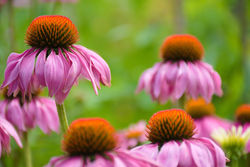Growing beautiful Dahlias in raised beds: A beginner's guide
- Lars Wildes
- Aug 16, 2023
- 3 min read
Updated: Aug 27, 2023
If you're excited by the idea of growing stunning dahlias but aren't sure where to start, look no further! We've put together the ultimate guide to help you cultivate these gorgeous flowers in raised beds.
Whether you're dealing with soggy soil or seeking a way to elevate your gardening game, raised beds could be your answer.
Why choose raised beds for dahlias?
If your garden soil doesn't drain well or holds too much water, raised beds can be your gardening superhero.
Especially if your area gets a lot of rain (like here in Denmark) or experiences flooding, raised beds can help your dahlias thrive.
Preparing your raised flower bed for planting dahlias
Think of it like this… your raised bed is like a cozy home for your dahlias.
That means you have to get the foundation right. Instead of filling up the entire box with soil — that can get expensive — start by placing tree branches, sticks, or logs at the bottom.
These natural materials break down slowly and help retain moisture.
Build layers by stacking logs, then adding branches and sticks, followed by leaves and grass clippings. Just ensure the clippings are from a pesticide-free lawn.
Remember, the initial setup takes the most effort. But once that's done, maintaining your raised bed becomes much simpler.
It’s as simple as adding a bit of fresh compost on top each year and mixing it in with the soil.

Creating the perfect soil mix for dahlias
Creating the right soil mixture is like crafting a recipe for success. If you're lucky, you can gather compost from your local composting facility or, if you’re like us, you’re already composting because you know how valuable it is for your garden.
For your raised bed, mix the compost with garden soil. Roughly 20% to 25% of your soil volume should consist of compost and soil conditioner (optional).
Since dahlias are your stars, ensure you have at least 10 inches (25 centimeters) of soil depth, as you'll plant the tubers around 5 inches (12.7 centimeters) deep.
Planting your dahlia tubers
Your raised beds are now ready for their occupants!
For planting, dig holes around 8 inches (20 centimeters) deep. Add some compost at the bottom of the hole. Then, place your dahlia tuber, with the eye facing upward, and cover it with the rest of the soil/compost mix.
Supporting your dahlias (literally)
Dahlias may need a little help standing tall. Install posts and netting for support or use thin bamboo poles and yarn like we did.
Adjust the height as needed. You want support at around 12 inches (30 centimeters) and more at about 24 inches (60 centimeters) high.
If you’re going with stakes or a trellis, tie the plants every 12 to 18 inches (30 to 45 centimeters) using baling twine or plastic ties. Avoid tying them too tight to prevent damage.
Dahlia watering and care
Dahlias love a good drink. They require about 1 inch (2.5 centimeters) of water per week.
Of course you’ll need to adjust your watering schedule based on rainfall and the temperatures in your area. In hot weather, consider misting them in the afternoon to cool them down.
Mulching magic
As your dahlia plants grow to at least 6 inches (15 centimeters) tall, add a few inches of mulch around each one.
This helps retain moisture, suppress weeds, and keep the roots cool. But make sure not to smother the base of the dahlia by pulling the mulch a few inches away.

Enjoying the gorgeous dahlia blooms
As summer rolls in, your dahlias will burst into bloom and continue their show until frost arrives.
To encourage bushier growth and more blooms, pinch back the plants to 3 or 4 leaf nodes before they become too tall. We do this when the plants are around 20 centimeters tall.
And remember to deadhead when blooms are spent to encourage even more flowers.
Your raised bed will soon become a haven of vibrant dahlia colors, rewarding you for your gardening efforts.
So there you have it, the basics that you need to know to grow stunning dahlias in raised beds.
With a little care and attention, your garden will soon be flourishing with these enchanting blooms.






Comments